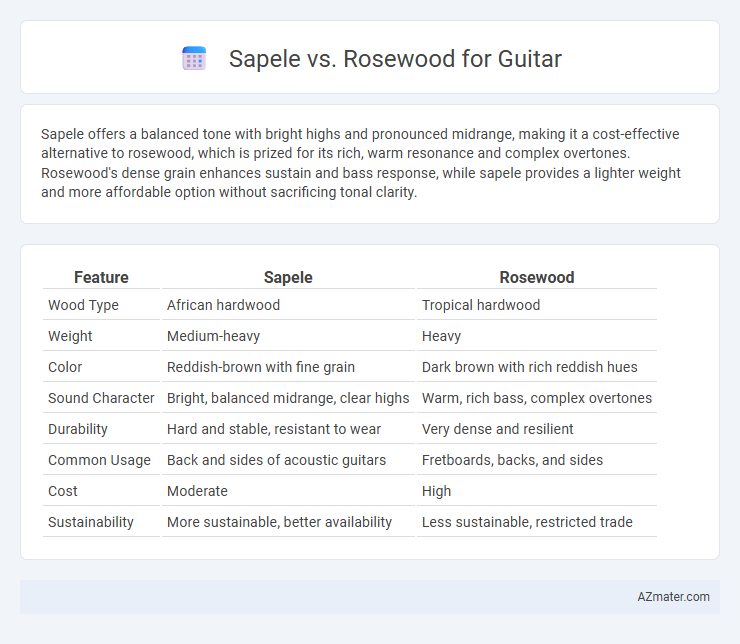Sapele offers a balanced tone with bright highs and pronounced midrange, making it a cost-effective alternative to rosewood, which is prized for its rich, warm resonance and complex overtones. Rosewood's dense grain enhances sustain and bass response, while sapele provides a lighter weight and more affordable option without sacrificing tonal clarity.
Table of Comparison
| Feature | Sapele | Rosewood |
|---|---|---|
| Wood Type | African hardwood | Tropical hardwood |
| Weight | Medium-heavy | Heavy |
| Color | Reddish-brown with fine grain | Dark brown with rich reddish hues |
| Sound Character | Bright, balanced midrange, clear highs | Warm, rich bass, complex overtones |
| Durability | Hard and stable, resistant to wear | Very dense and resilient |
| Common Usage | Back and sides of acoustic guitars | Fretboards, backs, and sides |
| Cost | Moderate | High |
| Sustainability | More sustainable, better availability | Less sustainable, restricted trade |
Introduction: Sapele vs Rosewood for Guitars
Sapele and rosewood are popular tonewoods used for guitar construction, each offering distinct acoustic and aesthetic qualities. Sapele provides a bright, focused sound with enhanced midrange clarity, making it ideal for players seeking articulation and balance. Rosewood is prized for its rich, warm tones and complex overtones, contributing depth and resonance favored in both acoustic and electric guitars.
Origins and Botanical Differences
Sapele (Entandrophragma cylindricum) originates from West Africa and is prized for its tight grain and medium weight, offering a bright tone with clear midrange, while Rosewood typically comes from the Dalbergia genus found in India, Brazil, and Madagascar, known for its oily texture and rich, complex tonal qualities. Botanically, Sapele belongs to the Meliaceae family with interlocking grain patterns and a uniform color ranging from golden to reddish-brown, whereas Rosewood is part of the Fabaceae family, featuring dense, oily wood with dark streaks and a more porous structure. These botanical differences influence the guitars' sound projection, aesthetics, and durability, with Sapele providing a brighter, more focused sound and Rosewood delivering a warmer, bass-heavy tone with pronounced overtones.
Visual Appearance and Grain Patterns
Sapele features a rich reddish-brown hue with a subtle, interlocking grain pattern that produces a shimmering, almost ribbon-like effect, providing a classy yet understated aesthetic. Rosewood exhibits deeper color variations ranging from dark brown to purple, often highlighted by intricate, swirling grain patterns that create a dramatic, luxurious look. The pronounced figuring and contrasting streaks in rosewood make it a preferred choice for players seeking a visually striking guitar, while sapele offers a more consistent and refined appearance.
Tonewood Properties: Sound and Resonance
Sapele offers a bright, balanced tone with strong midrange presence and excellent sustain, making it a versatile choice for guitars. Rosewood provides a rich, warm sound characterized by deep bass, complex overtones, and natural resonance that enhances harmonic richness. Both tonewoods deliver distinct resonance qualities, with Sapele producing a punchy response and Rosewood emphasizing depth and clarity in acoustic performance.
Durability and Longevity
Sapele offers strong durability with a dense grain structure that resists wear and moisture, making it ideal for long-lasting guitar bodies. Rosewood, prized for its hardness and natural oils, provides exceptional resistance against cracking and warping over time. Both woods ensure longevity, but rosewood's superior density and natural preservatives typically result in greater durability for guitars subjected to varying environmental conditions.
Workability for Guitar Builders
Sapele offers guitar builders exceptional workability due to its straight grain and medium-density, allowing smooth planing and reliable shaping without excessive tool wear. Rosewood, while prized for its tonal richness, can be challenging to work with because of its oily texture and dense hardness, which often dulls tools faster and requires more effort to achieve fine detail. Builders value Sapele for consistent machining and finishing ease, whereas Rosewood demands greater skill and maintenance for optimal craftsmanship.
Availability and Environmental Impact
Sapele is more readily available and sustainably sourced compared to traditional rosewood, which faces strict trade restrictions under CITES due to overharvesting. Rosewood's scarcity has led to increased illegal logging and environmental degradation, while sapele offers a responsible alternative with similar tonal qualities. Choosing sapele supports conservation efforts and reduces the environmental impact associated with rosewood extraction.
Price Comparison and Value
Sapele guitars typically cost less than rosewood models, offering a budget-friendly option without sacrificing tonal quality. Rosewood is prized for its rich, warm sustain and superior resonance, commanding higher prices due to its rarity and aesthetic appeal. Choosing sapele provides excellent value for players seeking durability and balanced sound, while rosewood delivers premium tonal depth that justifies its investment for professional-grade instruments.
Popular Guitar Brands and Model Examples
Sapele is commonly used by brands like Yamaha and Ibanez for models such as the Yamaha FG800 and Ibanez AW54, valued for its balanced tone and affordability. Rosewood, often featured in high-end guitars like Martin D-28 and Taylor 814ce, is prized for its rich resonance and complex overtones in fingerstyle and acoustic play. Both tonewoods influence guitar sound and aesthetics, with Sapele providing warmth comparable to mahogany and Rosewood delivering deep bass and sparkling highs favored in premium acoustic guitars.
Choosing the Right Wood: Sapele or Rosewood?
Sapele offers a bright, clear tone with strong midrange presence, making it ideal for players seeking a balanced sound with excellent projection. Rosewood, prized for its rich, warm overtones and complex harmonics, is favored for fingerstyle and genres requiring deep, resonant bass response. When choosing the right wood for a guitar, consider Sapele for durability and affordability with a bright sound, while Rosewood excels in delivering luxurious tonal depth and sustain.

Infographic: Sapele vs Rosewood for Guitar
 azmater.com
azmater.com